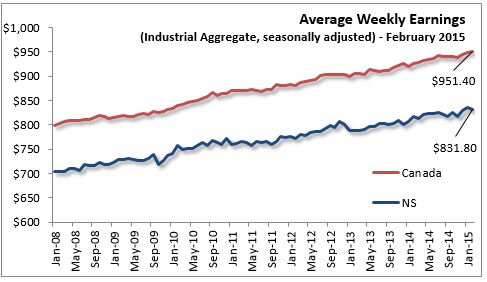To view previous releases, select one from the dropdown box:
Currently displaying information released on: November, 2017
STUDY: INTRA-HOUSEHOLD LABOUR INCOME RESPONSES TO CHANGES IN TAX RATES
Faced with an aging workforce, increasing life expectancies and pressure on the solvency of public pension plans, Canadian governments have responded by increasing the retirement age, provided incentives to increase older workers (income-splitting pension incomes) to remain in the labour force, and improved the sustainability of public pension systems.
Recently, Statistics Canada released its study in the Daily on Intra-household Labour...
View complete article..
LABOUR FORCE SURVEY - OCTOBER 2017
In Nova Scotia October 2017 (seasonally-adjusted, month-over-month and year-over-year):
- Labour force decreased 0.2% (-1,000) from September 2017 to 490,200 and increased 1.6% (+7,700) over October 2016.
- Employment increased 0.2% (+700) from September 2017 to 447,600 and increased 0.5% (+2,200) over October 2016.
- Unemployment decreased 3.8% (-1,700) from September 2017 to 42,600 and increased 14.8% (+5,500) over October 2016.
- Un...
View complete article..
LABOUR MARKET TRENDS - OCTOBER 2017
Nova Scotia's seasonally adjusted employment increased by 700 to 447,600 in October 2017. This is the first back-to back monthly employment increase since the start of 2017.
Compared to September, Nova Scotia’s labour force decreased by 1,000 to 490,200 in October. With a falling labour supply combined with a slight increase in labour demand, the net result was a 0.3 percentage point decline in the seasonally adjusted unemployment rate to 8.7 per ce...
View complete article..
JOB VACANCIES AND WAGES, Q4 2023
Nova Scotia's job vacancy rate (seasonally adjusted) was 3.6% in Q4 2023, representing 15,940 job vacancies. Nova Scotia's job vacancy rate declined from 4.0% in Q3 2023.
Nationally, the job vacancy rate was 3.8%, down 0.1 percentage points from Q3. The highest job vacancy rate was reported in Saskatchewan while the lowest job vacancy rates were in Newfoundland and Labrador. &nb...
View complete article..
EMPLOYMENT INSURANCE FEBRUARY 2015
In February 2015, the number (seasonally adjusted) of Nova Scotians receiving regular Employment Insurance (EI) benefits increased by 580 persons (2.2%) from the previous month to 27,190 and increased by 160 persons (0.6%) over February 2014.
In February 2015, the number (seasonally adjusted) of Canadians receiving regular EI benefits increased by 9,940 persons (2.0%) from the previous month to 509,780 and declined by 3,470 (-0.7%) over February ...
View complete article..
EMPLOYMENT, EARNINGS AND HOURS, FEBRUARY 2015
Nova Scotians' average weekly earnings (including overtime, seasonally adjusted) decreased $3.98 per week (-0.5%) from January to $831.80 in February 2015. This is 1.9 per cent above the level in February of last year. Canadians' average weekly wages increased 0.3 per cent from January to $951.40 in February 2015, a 2.7 percent increase over February 2014.

View complete article..
|